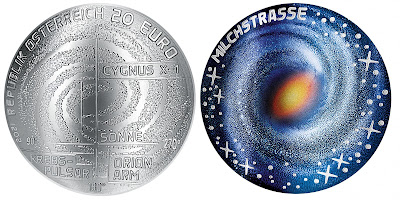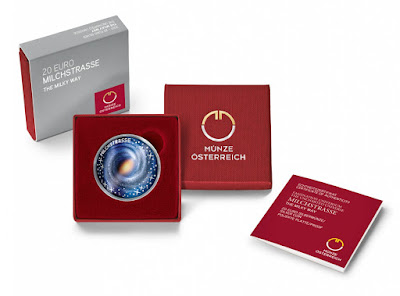1788) "The Milky Way Galaxy", Austria: First Coin in a Silver 20 Euro three-Coin Series, titled "The Uncharted Universe," minted by the Austrian Mint, Vienna: Date of Coin issue: 12.05.2021:
The "Uncharted Universe Coin Series":
The Header/Banner showing The Milky Way, the Obverse and Reverse of the 20 Euro Silver Coin, and the Austrian Mint Logo ("MUNZE OSTERREICH"). It is titled "DAS UNCHARTED UNIVERSUM ("The Uncharted Universe"). Also seen is the "S" shaped structure of the Coin.
Humans have been fascinated by the vastness of the universe and the more one learns about it the more fascinated one becomes. With the help of these coins and what one learns about the universe along the way, one will reach the final frontier, beyond which lie the unknown and the unexplored.
Consisting of three coins, the Silver 20 Euro "The Uncharted Universe Coin Series" takes us to the deepest depths of the universe and gives the beholder a fascinating glimpse of three physical-astronomical phenomena.
Together with experts, this Coin Series takes a close look at three physical-astronomical phenomena – "The Milky Way", "Black Holes" and "Neutron Stars". After the Milky Way (First Coin in the Series), the Series focusses on the still-unexplained marvels of Black Holes and even Neutron Stars.
The "Milky Way Galaxy" - the First Coin in the Series:
The S-shaped first coin in the series, The Milky Way, is curved in a similar way to our home galaxy. The story it tells about the cosmos also features surprising twists and turns.
The study of astronomy is one of the oldest natural sciences, from the Greek word ἀστρονομία (“astronomia“), which literally means the science that studies the laws of the stars.
Early civilisations in recorded history have made their contribution to the natural science that studies celestial objects and phenomena from the Indians, Babylonians, Greeks, Egyptians, Maya, and ancient indigenous peoples of the Americas.
All have made methodical observations of the night sky and have offered insight into our home galaxy we have come to know as the Milky Way.
Its name "The Milky Way" is derived from the Ancient Greek Myth about the goddess Hera who sprayed milk across the sky, thus the vast spans of stars. The ancient Greeks associated the milky band of light that we see when we look into the clear night sky with Heracles, who as a baby sucked on the goddess Hera’s breast so hard that she withdrew it from his mouth, spilling her milk over the sky.
Containing at least 100 billion stars, the observable universe itself contains at least 100 billion galaxies.
Though astronomers had long suspected the Milky Way was made up of stars, it was in 1610 when Italian Galileo Galilei (1564–1642) turned his rudimentary telescope towards the heavens and found that the bands across the sky were made up of individual stars.
Astronomers thereafter realised there were many, many more stars in the sky and all of the stars we could obverse are a part of the Milky Way.
By that time, Polish mathematician and astronomer Nicolaus Copernicus (1473–1543) had already discredited the long-held belief that the Earth, rather than the Sun, was the centre of the universe.
Galileo was able to show that the Sun was just one of a multitude of stars in the Milky Way.
The Western view was shaken again in 1920 when Edwin Hubble showed that the Milky Way is just one among many galaxies.
Although this made the earth seem increasingly insignificant, the smaller the planet felt, the greater our knowledge of outer space became and the more astronomers began to understand our physical place in the cosmos.
The Coin:
From something very small – a coin – one becomes acquainted with the infinitely large and even reach out to galaxies that no human has ever seen before.
The Obverse and Reverse faces of the Milky Way Coin.
This image shows the Obverse & Reverse standing on their edges and the angular S-shaped design of the coin.
On the Obverse of the 20 Euro Silver Coin, the combination of the convex and the concave surfaces results in an S-shaped Silver surface upon which the Milky Way is depicted.
The peripheral inscriptions are - "REPUBLIK OSTERREICH" ("Republic of Austria"), "20 EURO".
The angular dimensions of the galactic coordinate system show the position of the sun in relation to the rest of our galaxy.
The position of the "Orion Arm", in which our solar system is located, is also marked.
So are the positions of the astronomical phenomena "Cygnus X-1" and "Krebs Pulsar" (Crab Pulsar), which play a special role on the other two coins in the series.
These positions also play a special role on the other two coins in the series and will be clearly seen when they are released later in the year.
The Reverse of the 20 Euro Silver Coin features the same image of the spiralled Milky Way, though in spectacular, colour-printed form.
The “Uncharted Universe” Collector Case:
A specially designed Collector Case is available to house and present the three-coin set. The substance of the universe is brought to the point and stored in a stylish cassette. The lid is attached with magnets and can be removed, the insert can be opened, so the coins can be viewed from both sides.
The inlay can be set up in such a way that the case can be easily turned into a mini-exhibit of the universe, in which the phenomena on the coins can be explored from both sides.
The specifications of this Coin are:
Country of issue: Republic of Austria; Coin Series Name: "The Uncharted Universe"; Coin Theme: "The Milky Way"; Date/Year: 12.05.2021; Denomination/Face Value: 20 Euros; Metal Composition: .925 Fineness Silver (Ag); Fine Weight: 20.74 grams or 0.67 Oz; Total Weight: 22.42 grams; Diameter/Size: 34.00 mm; Coin Quality: Proof with Applied Colour; Mintage: 2,500 pieces; Special Technique: S shaped Silver surface; Mint: Mint of Austria, Vienna; Mintage: 30,000 pieces; Presentation Box/Case: Yes; Certificate of Authenticity (COA): Yes; Coin Designer: Mag. Helmut Andexlinger.
- Each coin is specially encapsulated to accommodate its unique shape and surface and is presented in an attractive case with a numbered certificate of authenticity.
- Packaging comes in a Case complete with a numbered Certificate of Authenticity (COA) and protective slipcase.
14) Alfred Adler: The Vienna schools of Psychotherapy: A 3 coin 50 Euro Gold Coin Series:
15) The 100th Anniversary of the General Theory of Relativity by Albert Einstein: Gold and Silver Coins issued by the Royal Mint of Belgium in denominations of 50 Euro (Gold) and 10 Euro (Silver)
16) 825 Years of the Vienna Mint (1194-2018): A Silver Bullion Coin issued by the Austrian Mint, Vienna celebrating the milestone (issuedate: 12/12 - with year of issue engraved as 2019
8) Graf Zeppelin: A 20 Dollar Silver coin and a 5 Dollar Gold Coin issued by Cook Islands in April 2017 to commemorate the 100th Death Anniversary of Count Ferdinand Adolf Heinrich August von Zeppelin (08.07.1838 - 08.03.1917)
9) A "Hundert Mark" (Hundred Mark) Reichbanknote dated 1st November 1920 tells a tale of a time when hyperinflation was rampant in Germany after World War I
11) "An Land" (On The Land): A 10 Euro Coin: The second "Tri-material" Coin in the Series titled "Air Moves" - with an outer ring, inner core and an embossable polymer ring: Innovative coin issued by the Federal Republic of Germany in 2020
3) Sub-Tropical Climate Zone: ("Climate Zones of Earth Coin Series"): The second "tri-material" Coin in the Series - with an outer ring, inner core and an embossable orange polymer ring, innivative coin issued by the Federal Republic of Germany on 26.04.2018
4) In the Air: A 10 Euro Coin: The first Coin in the 3 coin Bimetal/Polymer coin "Tri-material" Coin Series titled "Air Moves", to be issued in April 2019
7) Michelangelo's "Pieta", Vatican City: New Copper Coin Series titled "Art and Faithy": A 10 Euro Copper Coin minted by the "Istituto Poligrafico e Zecca Dello Stato" (IPZS) on behalf of the "Ufficio Filatelico e Numismatico Governatorato della Cotta del Vaticano": Coin issue date: 05.03.2020
8) Ancient Postal Routes, Vatican City State: EUROPA 2020 Theme: Two stamps of 1.10 Euro and 1.15 Euro issued by the Ufficio filatelico e Numismatico -Governatorato, Vaticano featuring Ancient Postal Routes emanating from the Vatican City State during the 6th & 11th Centuries AD








No comments:
Post a Comment